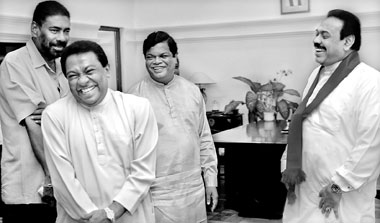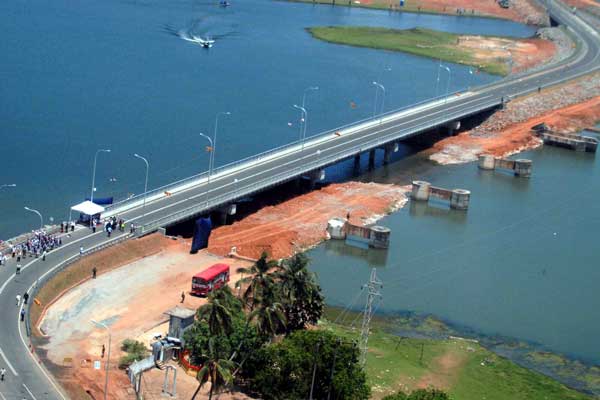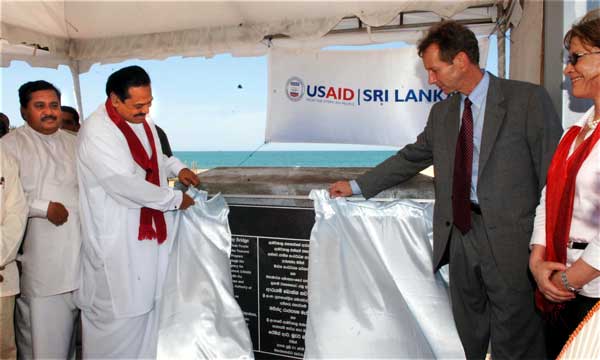Last Tuesday President Mahinda Rajapaksa travelled to Arugam Bay in the East for the ceremonial opening of the bridge that links Pottuvil, Arugam Bay and Panama. It replaces the former bridge over Arugam Bay that was “destroyed” (sic) in the tsunami of December 2004.
The $10 million bridge is considered the flagship project of the US GovernmentA?a??a??s $134 million tsunami reconstruction assistance programme in Sri Lanka and will provide an important boost to economic development in the Eastern Province.
Apart from this demonstration of the friendship between the United States and Sri Lanka, this bridge is also a symbol of the GovernmentA?a??a??s commitment to develop the East, and its opening was very much in sync with the Negenahira Udawa or Eastern Re-awakening programme.
This was one more practical example of the PresidentA?a??a??s policy of going ahead with development, despite the huge costs and other problems caused by the ongoing military operations to defeat terrorism.
With this new bridge the people in vast areas of the East that were largely separated will be brought much closer and many opportunities will be opened for more economic activities in these areas.
It is the importance of this bridge in improving the living conditions of people in the East, and giving them the opportunity to fully enjoy their liberation from the terror of the LTTE that prompted the President to be there in person for this event.
It is possibly the symbolism that the new Arugam Bay Bridge and its ceremonial opening gave to the GovernmentA?a??a??s efforts towards help realize the aspirations of the people of the East that made the LTTE pick on this particular event to attempt an attack on the PresidentA?a??a??s entourage, hoping it would be able to get at the President himself. The attempt failed. What was struck in the failed attempt was a back up helicopter that had gone to re-fuel after the choppers that brought the PresidentA?a??a??s party to the event had safely landed at Arugam Bay.
This was not a military event. It was also an event with diplomatic presence, including Evan Feigenbaum, the US Deputy Assistant Secretary of State for South and Central Asian Affairs, who was there because of the US contribution for the new bridge, both in funds and expertise.
This was a peaceful event that was intended to provide better living conditions for the people of the East, including its Tamil people, whose liberation the LTTE claims it is fighting for.
In considering all of this, the LTTEA?a??a??s action last Tuesday in targeting a chopper of the PresidentA?a??a??s entourage, albeit one that had no passengers and was returning from fuelling, can only be seen both as a gross act of cowardice as well as one of monumental folly.
Cold-blooded
TULF leader V. Anandasangaree put this act of the LTTE in perspective when he described it as barbaric conduct, and showed how such acts can compel the whole world to join hands to crush it.
In a statement issued from Paris, the TULF leader and UNESCO Madanjeet Singh laureate on tolerance and non-violence, while condemning the attack, sought to tell Velupillai Prabhakaran that this attempted assassination was not less foolish than the cold-blooded murder of the former Prime Minister of India, Rajiv Gandhi, masterminded by the LTTE leader.
His statement warned Prabhakaran that, this type of barbaric conduct on your part, which is virtually a challenge to the International Community, must cease immediately and the LTTE should agree for talks with the Government and lay down arms unconditionally.
At this rate they will lose even the little sympathy the International Community has for their cause – and not for them – resulting in the whole world joining hands to crush them completely. The developments that are taking place in different countries clearly show that this will take place sooner or later.
Whatever the LTTE may think of the GovernmentA?a??a??s strategies of development and seeking to give the people of the East the real fruits of their liberation from Armed Oppressors, there is ample evidence to show that the policy of the President and this Government lays stress on development, and especially the importance of connectivity and easier transport to achieve the tasks of development.
It was not long ago that the Government opened that other important bridge at Manampitiya, a new bridge that replaced the old rail-road bridge that was also washed away in the tsunami.
This was also an important opening to the East and is already showing the benefits it has brought to the people, especially in improving their economic conditions.
Road Builder
Order uroxatral generic
The very word A?a??E?bridgesA?a??a?? indicates the bringing together of people and communities, of crossing barriers. They are a means of closer interaction among people who may have been separated for too long due to physical barriers.
As much as bridges reduce distances and bring people closer, making a significant contribution to the economic development of an area, they also help bring about understanding among people who have been kept apart for long, not only because of terrain, but also due to divisive politics and Armed attempts at destabilisation of the State and moves for separation.
The barbarism of the LTTE would not want to see any bridges built that would bring the people of this country together again, and take them on the path to peace and prosperity. The mindset of the terrorist does not want to see the divisions that they have either caused or exacerbated among communities heal, and the roots of tolerance and understanding take hold.
The terrorist, especially Prabhakaran and the LTTE, would think it best to kill off both the message and the messenger, the message being that of peace, understanding and reconciliation, and the messenger in this instance being the President, who having given the leadership to the liberation of the East from the clutches of terror, is actively working towards developing the region to give opportunities for advancement to the Sinhalese, Tamil and Muslim communities there.
More bridges will have to be built for this, and so it will be, despite the displeasure this may give to the LTTE.
Moving from bridges to roads, although there are many who say that there has been no development under this Government, this charge is contradicted when one sees the amount of work it has done in the area of providing better road facilities to the people.
If the British Governor Barnes gained repute as the Great Road Builder of Ceylon, it could well be that Mahinda Rajapaksa will rightly earn the honour and reputation of being the greatest road builder since independence.
This is best seen in the rural areas where there are literally thousands of kilometres of concrete surfaced roads, where once there were only cart tracks or paths where no vehicle could travel, bringing a great boon to the often neglected rural people.
This is also true of the national highways, where the road surfacing in most areas has been improved and new roads have been built or are being built where there was none earlier. Midst all this there is certainly a shortcoming seen in the roads maintained by the Provincial Councils.
This is a matter that will have to be addressed very soon both by the Government that allocates funds for development work of the PCs, as well as the public who will have to make the PCs more answerable to them on matters of development, especially road building and maintenance.
In the task of bringing people together the decided policy of this government includes the building of more than 200 bridges, which will contribute a great deal to bringing people and communities closer, making a positive impact on their livelihoods and economic opportunities, as well as paving the way for peace and understanding, whatever the LTTE or those opposed to such progress may feel about it.
Last stand
While Anandasangaree says the LTTEA?a??a??s barbarism would soon result in the whole world joining hands to crush them completely and that developments already taking place in different countries clearly show that this will take place sooner or later, there are more reports of the LTTEA?a??a??s growing weakness in the light of the military operations to eliminate terrorism from the country.
The latest such report is from A?a??E?Strategy PageA?a??a??, the authoritative website on military matters the world over. Earlier this week A?a??E?Strategy PageA?a??a?? reported that with more and more civilians living in North sneaking into Government controlled areas, the LTTE has mobilised everyone and everything for what appears to be a A?a??A?last stand,A?a??A? adding that A?a??E?Most of the Tamils in the North donA?a??a??t want to be a part of that [last stand], but opposing the LTTE can get you killed. So those who can are fleeing.A?a??a??
According to A?a??E?Strategy PageA?a??a?? most of the LTTE recruits are poorly trained, led largely via threats to themselves and their families and suffering from low morale. There is little ammo, because of the Navy blockade and the destruction of most of the LTTE boats.
The Government artillery and Air Force are finding more targets, thanks to the interrogation of captured or deserted LTTE fighters, and the long range army patrols inside LTTE territory.
By containing the LTTE to a small portion of the northern coast, the rest of the country has prospered. GDP was up 6.8 per cent last year, and is headed for a seven per cent increase this year,A?a??a?? it further said.
This analysis of the LTTEA?a??a??s increasing military weakness is supported by a writer in the Observer Magazine, special section of The Observer, one of the UKA?a??a??s leading mainstream Sunday newspapers, well known for its independent reporting and analysis. Euan Ferguson writing in last SundayA?a??a??s (June 29) issue of the Observer Magazine describes how the LTTE in its frustration at being thwarted in their attacks on the Government and military, are going for the softest targets of all, the impoverished working people of Sri Lanka.
He gives detailed accounts of how A?a??E?the LTTE, essentially pinned down in two territories, have taken to bombs, on trains and on busesA?a??a??, and that: A?a??E?Desperate tactics have been adopted by the Tigers, but there are increasing signs that by targeting innocent civilians they are fast losing whatever sympathies they once had within the majority Sinhalese populationA?a??a??. Not very far from what Anandasangaree states:
It adds that there has for long been fundraising in the UK for the LTTE; with the Sri Lankan Government estimating that 70m pounds is raised annually in Britain, despite the LTTE being a proscribed organization there.
Bus bombs and suicide killings
Writer Ferguson who has visited Sri Lanka for a second time (the first being in the aftermath of the tsunami in December 2004) describes in considerable detail, not seen by most wire service reports and those of quick-stop, fly-by-night foreign correspondents, how the LTTE targets the civilian population of Sri Lanka, especially its use of bus bombs and suicide killers, as it fails to make any gains in direct confrontations with the countryA?a??a??s Armed Forces.
The number of incidents reported show the writer has spent some time in Sri Lanka and had bothered to visit some of the sites of the tragedies caused by the LTTEA?a??a??s increasing barbarism.
Here are some relevant excerpts about the LTTEA?a??a??s bus bombs and suicide killings from the article titled A?a??E?Lost in ParadiseA?a??a??:
A?a??A?Here are not only the Liberation Tigers of Tamil Eelam (LTTE) but their offshoot, the Black Tigers, the suicide squads. According to JaneA?a??a??s Information Group, between 1980 and 2000 the Tigers had carried out a total of 168 suicide attacks on civilians and military targets, easily exceeding those in the same period by Hezbollah and Hamas combined.
And, now, today, thwarted in their attacks on the Government and military, theyA?a??a??re going for the softest targets of all, the impoverished working people of Sri Lanka. The gloves came off again at the start of 2008, with the Government vowing to break the Tigers within a year.A?a??A?
A?a??A?For all those decades of suicide practice, youA?a??a??d think they might be getting the hang of it by now. But in ColomboA?a??a??s Fort Railway Station, a few weeks before my visit, it all went wrong again.
A female suicide bomber, coming off a train from the south, was spotted acting oddly by police – too many clothes for the cloying heat – and fled from the turnstile back into the station. By platform three she sat down and exploded. She took 11 others with her. The 11 dead included half a high school baseball team, and 92 were injured.A?a??A?
A?a??A?Indrani Fernando, saw a suspicious bag left under a seat near the back. When no one claimed it I told the crew and shouted at people to get off,A?a??a?? she says.
The bus halted in the middle of a junction and everyone filed off and began walking away, rather quickly, and the police were called.
Twenty seconds after the driver and conductor had climbed off, the bomb exploded: 10 passers-by were injured, among them children. Indrani later took a congratulatory call from the President, Mahinda Rajapaksa, thanking her for her vigilance. I go to see the bus, towed two miles away. The carcass is eviscerated, skeletal: no one would have survived.A?a??A?
A?a??A?Just before I arrived in Sri Lanka, another bus had been blown up a couple of kilometres outside Dambulla, an ancient holy rest-stop on the journey to the East. The 18 killed were almost all pilgrims, and included children.
In the remote southern town of Buttala the rebels had recently failed to kill most of the passengers on a bus with a simple bomb; so they gunned down 32 of them as they fled, in flames.
A?a??A?Desperate tactics have been adopted by the Tigers, but there are increasing signs that by targeting innocent civilians they are fast losing whatever sympathies they once had within the majority Sinhalese population.A?a??A?
A?a??A?And the rebels, essentially pinned down in two territories, have taken to bombs, on trains and on buses.A?a??A?
A?a??A?The night before I fly out I wander down to the beach at Colombo. Within a couple of weeks, it turns out, this unconscionable little war will have erupted ever faster.
A suicide bomber exploded successfully at the start of a marathon just outside Colombo, killing 13 (including a Government Minister). Then a parcel was left on the overhead rack of a bus leaving the depot at Piliyandala, just south of the capital: the fireball killed 24 and injured scores.A?a??A? (Courtesy: Observer Magazine UK)
Attacks on media
The new IGP Jayantha Wickremaratne has a major task at hand, with those who attacked journalist Namal Perera and the Political Affairs Officer of the UK High Commission Mahendra Ratnaweera (a person who is very close to the media) virtually handing him the first big case in his new office.
One hopes that the time Wickremaratne spent as Media Spokesman for the Police would make him more understanding of the situation that prevails, and the worries that journalists and media organisations face today.
While the number of attacks on journalists has been increasing in recent months, and the Police apparently drawing blank on all of them, the IGP will no doubt see the new urgency in tackling this issue with the PresidentA?a??a??s own statement made at Arugam Bay last Tuesday, the day after the attack of Perera and Ratnaweera, when he referred to the existence of a conspiracy to jeopardise and smear the name of the Government through the attacks on journalists.
It is now the task of the Police to get to the bottom of this conspiracy, which one hopes will see the end of this spate of attacks, that is certainly not helping in giving a good image to Sri Lanka and the Government, however sceptical some may be of the reasons for these attacks.
Going by the record so far, it is evident that it is not the number of police teams involved in any probe that matters, but the quality of the personnel and the direction given by those at the top of the Police. IGP Wickremaratne has thus found the best opportunity to prove his mettle as a police officer committed to upholding the Rule of Law.
source:
http://www.dailynews.lk/2008/07/05/fea02.asp

 President Mahinda Rajapaksa is moving strategically to win the two provincial council elections. He has the political acumen and versatility to convince the electorate that the UPFA government is doing the best for Sri Lanka as far as the economy and the war are concerned.
President Mahinda Rajapaksa is moving strategically to win the two provincial council elections. He has the political acumen and versatility to convince the electorate that the UPFA government is doing the best for Sri Lanka as far as the economy and the war are concerned.












 Arugam Forum
Arugam Forum Arugam Photo Galleries on Picasa
Arugam Photo Galleries on Picasa Old Website
Old Website Press Coverage
Press Coverage Surf Forecast for Arugam Bay
Surf Forecast for Arugam Bay
TODAY’s Comments